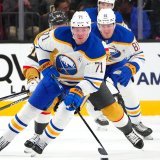Like most things in life, the results you can expect to achieve from something -- be it work, school, sports, a relationship, etc -- depend largely on the time and effort you put into it. In other words, preparation is key.
The world of fantasy sports is no different. If you show up to the draft table wet behind the ears with no idea what you're getting into, you can pretty much guess what the eventual outcome will be. Where fantasy hockey is concerned, when going up against fantasy veterans who live, eat and breathe the stuff, you have to bring your game up to their level. Sure, everyone relies on a handful of "lucky picks" over the course of a season to help them out, but even lucky picks have to be backed up by hard work, research, and plenty of time studying player stats. Bottom line, if you don't do your homework, you're in trouble. Prepare! Don't wing it.
With that said, here are a handful of ground rules to know before draft day rolls around. If you follow these basic guidelines, you should be able to put together a solid roster that even the most seasoned fantasy pros will look at it and say, "Yep, he's got a chance."
Know your league's point system. Every league is different, so make sure you know how yours works. If goals are worth twice as much as assists, you have to adjust your player rankings accordingly. If wins and shutouts make goalie stats a big component of your overall score, make sure you have plenty of netminders near the top of your draft list. Better still, try and get a hold of the league's final results from last year. Take a look at the team that won and try to identify the keys to that owner's success. Did they ride a couple of hot goalies all the way to the title? Did a handful of "sleeper" picks put the squad over the edge? Did they have a mediocre group of forwards but a dynamite defense corps? The details of any league's scoring system will very often contain clues or hints that will allow you to maximize your chances of beating it.
Do your summer reading. The summer months are typically quiet in the hockey world, but that doesn't mean you can afford to lay in a hammock all day sipping margaritas. Pay attention to the headlines. There's usually a flurry of player movement at the start of July when free agent season opens. After that, activity usually slows to a crawl with a few signings per week until training camps open in September. Fantasy hockey magazines normally hit the newsstands in August -- pick up one or two of these and make sure you know which players went where during the offseason. Some players leave the NHL altogether to go play in Europe -- know who these guys are so you're not calling their names on draft day. Know who the contract holdouts are, and which guys have retired. Bottom line: Minimize the "surprise factor." You don't want to be that owner at the table who has obviously just come from the newsstand and is looking over stats for the first time.
Study the trends. Know who the Steady Eddie players are, -- guys who post similar point totals year in and year out -- versus the guys who are all over the map. For example, say you're in the later rounds on draft day and you're down to the 40-point per season guys. You can either take Todd Bertuzzi or a guy like Brian Rolston. Both guys have averaged 43 points over the past three seasons, but Bertuzzi's record is 44, 44 and 40 points, whereas Rolston's record is 37, 32, 59. If it's me, I'm taking Steady Eddie Bertuzzi over Rolston, who is too much of a question mark with a risk of underperforming. Also, know which players are due for a bounce-back after one bad season.
Don't be afraid of injuries. In 2008-09, Paul Stastny suffered an assortment of injuries, many of the "freak," one-time variety that limited him to just 45 games and 36 points, well off the 75-plus points he's usually good for. At the start of 2009-10, those 36 points may have caused some poolies to drop Stastny lower on their draft sheets than he really should have been. However, the smart ones would have left him exactly where he was, viewing the 36-point season as a statistical aberration. The end result? Stastny followed up that 36-point effort with a 79-point campaign the following season. Bottom line: Injuries can happen to any player at any time. Don't let one injury-plagued season prevent you from drafting a solid player.
Draft by position. Most leagues require you to draft a certain number of players by position -- for example, four centers, four left wings, four right wings, six defensemen and two goalies. Center is widely considered the deepest position in fantasy hockey, so you can usually afford to lay off drafting one in the first few rounds of your draft. Looking at last year's stats, there were 16 centermen who scored 70 or more points. In comparison, only seven left wings were in 70-plus-point territory, and only six right wings. High-scoring defensemen are also relatively scarce, so don't wait until too late in your draft to start selecting blueliners.
Know your goalie strategy. Goalies are a slightly different story -- they can either be scarce or plentiful depending on how many you are required to draft, and how many other guys are at the table. Out of the 30 NHL teams, usually only 15 or so can lay claim to an "elite-level" goaltender. If there are less than 15 guys in your draft, and you only need one goalie each, you can usually afford to wait until the later rounds to draft one. If there are more than 15 guys and you are required to have more than one netminder on your roster, take at least one in the early rounds. Bottom line: You don't want to be the guy who gets stuck with Martin Brodeur's backup.
Have a "sleeper" list handy. These are players who come in under the radar and outperform everyone's expectations. A good example of this last season was Chris Stewart of Colorado, who came out of nowhere last year to lead the team in goal scoring, and ranked second in points. This will often happen because a player who was previously playing on one of his team's checking lines gets an opportunity to play a bigger role on a scoring line. Before the season starts, look for teams who have a hole in one or more of their scoring lines due to an injury or a trade. Now do a little research and try to identify who could fill that hole. It could either be a guy already on the roster or a young, up-and-comer from the minors.
At the end of the day, using the above guidelines will allow you to go into your draft as prepared as possible. None of this is rocket science, folks, but try and do as much advance reading and analysis as you can so you can relax on draft day and enjoy the experience. After all, fantasy hockey is supposed to be fun! So do your homework and prepare your cheatsheets. Then, when draft day rolls around, you can sit back with your beer and wings and call out your picks with confidence. And above all else, don't forget to engage in a little friendly trash talk!














